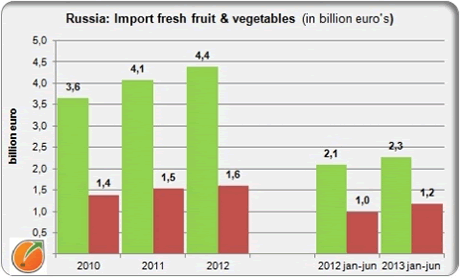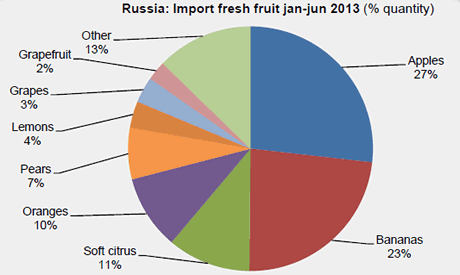3.2 million tonnes of fruit were imported in the first six months of this year. This is 8% more than in the same period last year. 1.5 million vegetables were imported in the period January/ June. This is a growth of 12% compared to the same months in 2012.

Large shifts in the import of apples; a lot more from Poland
Apples and bananas are the two largest imported fruits. The import of apples has grown by 14% in the first half year. There have been large shifts between the suppliers of this product. Western European countries supplied a lot less at the beginning of this year compared to the (beginning of) last year; Italy -51%, Belgium -15%, France -60%, Germany -57% and Holland -54%. A number of ZHR(?) countries also supplied considerably less apples to Russia; Chile -10%, Argentina -7%. More was imported from South Africa and New Zealand. China, as a secondary supplier, was also represented on the Russian market with a significantly smaller imported quantity (-10%). Poland, on the other hand, exported a lot more apples into Russia. Moldavia and Belarus exported also a lot more to Russia (table 6). Bananas mainly come from Ecuador and this is pretty much the only export product from this country to Russia.
Soft citrus and oranges are other important products. The import of both grew slightly in the first half of this year (+2%). The import of pears dropped considerably (-15%). The import from Belgium, the most important pear supplier to Russia on a yearly basis, plummeted (-43%). The import of pears from Holland fell even more (-60%). Larger shipments from Argentina, among others, couldn't compensate the total pear import at the beginning of this year (table 7).
A group of producers in the middle of the importing list of fresh fruit shows a strong increase in import in the first half year concerning: lemons (+11%), grapes (+18%), grapefruit (+23%), kiwis (+8%), peaches (+13%), strawberries (+8%) and apricots (+13%). Smaller fruit products of which the import has grown steadily are; avocados, mangos, figs and berries.
As far as fruit suppliers are concerned all important countries are showing significant growth percentages: Ecuador (+16%), Poland (+37%), Egypt+17%), Turkey (+12%) en Argentina (+15%). There is also a group with a decline in import: China (-44%), Spain(-10%) en Morocco(-18%).
More vegetables from Holland and Belgium
Tomatoes are Russia's most important imported vegetable product by far. Around half comes from Turkey. The total tomato import grew slightly in the first half of this year (+4%) but less came from Turkey (-7%). Holland is the sixth largest supplier. According to figures from Russian customs the import from Holland increased by over 10% in the first six months (table 5). Onions (in volume) are the second most important vegetable product. Holland is still the most important supplier, despite the large decline (by half) of supply in 2012. In the first half of the year the import from Holland recovered (+18%) (table 8). We can see something similar happen in the import of carrots from Holland: a decrease in the previous years and a recovery at the beginning of this year (table 9). Cabbage, on the other hand, was imported from Holland even less this year after the strong decline last year (table 10).

In total, Turkey is Russia's largest supplier of fresh vegetables. China is second and Israel is third, just in front of Holland. Poland, fifth on the list, is taking the opportunity to sell more and more fresh fruit and vegetables in Russia (table 3).
A lot less top fruit from Belgium
Belgium mainly supplies top fruit to Russia. The smaller supply of top fruit in the last season explains the strong decline of Belgian export to Russia. The export of fresh vegetables also decline strongly last year (mainly due to less export of carrots). There was a recovery in the first half of this year (table 13).







